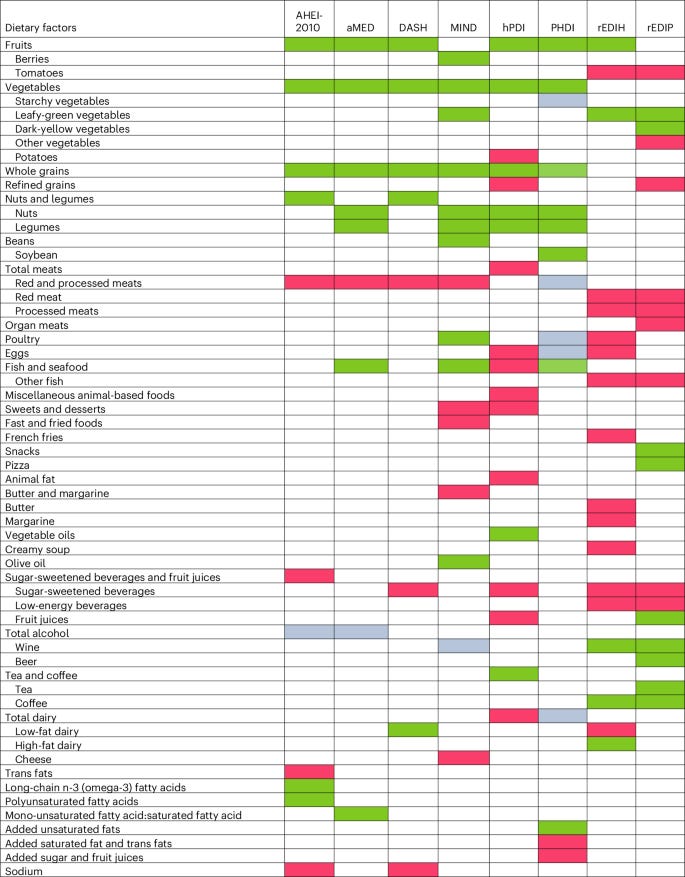A recent study published last week had everyone from my Dad (who went on to inform me that the Today show covered it), Husband and LinkedIn connections chattering. It is always a bit mind boggling to me how so many of these types of studies exist, but only a handful seem to catch people’s attention. And what it is about the ones that catch people’s attention is perplexing, when I try to find the common thread/theme, I come up empty.
The Study Findings (Study Link)
Diet is the first leading behavioral risk factor for noncommunicable diseases and mortality burden globally, therefore identifying diets that, beyond preventing noncommunicable diseases, optimally promote healthy aging.
World Health Organization acknowledged that prioritizing the preservation of functional ability and the prevention of capacity decline should be central to the model of healthy aging represening a paradigm shift away from the traditional disease-centric approach to aging
A longitudinal questionnaire and Follow-Up Study examined the association of long-term adherence to eight dietary patterns and ultraprocessed food consumption with healthy aging (based on measures of cognitive, physical and mental health, as well as living to 70 years of age free of chronic diseases).
After up to 30 years of follow-up “whoppping” 9% achieved healthy aging.
For each dietary pattern, higher adherence was associated with greater odds of healthy aging
The dietary patterns studied were Alternative Healthy Eating Index (AHEI), Alternative Mediterranean Index (aMED), the Dietary Approaches to Stop Hypertension (DASH), the Mediterranean-DASH Intervention for Neurodegenerative Delay (MIND), the healthful plant-based diet (hPDI), the Planetary Health Diet Index (PHDI), the empirically inflammatory dietary pattern (EDIP), the empirical dietary index for hyperinsulinemia (EDIH) and ultraprocessed food (UPF) consumption
When the age threshold for healthy aging was shifted to 75 years, the Alternative Healthy Eating Index diet showed the strongest association with healthy aging
The chart below is a great visualzation of the various diets (Pink: lower points or negative weights were assigned to higher intakes for this dietary factor; green: higher points or positive weights were assigned to higher intakes for this dietary factor; gray: higher points or positive weights were assigned to moderate intake.)
Higher intakes of fruits, vegetables, whole grains, unsaturated fats, nuts, legumes and low-fat dairy products were linked to greater odds of healthy aging, whereas higher intakes of trans fats, sodium, sugary beverages and red or processed meats (or both) were inversely associated.
Another chart chart below is quite informative for the details behind this finding
Higher intakes of fruits, whole grains, vegetables, added unsaturated fats, nuts, legumes and low-fat dairy were associated with greater odds of healthy aging, higher intakes of trans fats, sodium, total meats, and red and processed meats were associated with lower odds. These foods or nutrients were also consistently associated with each healthy aging domain. Added unsaturated fat intake, including polyunsaturated fatty acids, was particularly associated with surviving to the age of 70 years, and intact physical and cognitive functions.
Higher UPF consumption (comparing the highest quintile to the lowest) was associated with 32% lower odds of healthy aging. Higher consumption of UPFs was also associated with lower odds of maintaining intact cognitive function, physical function and mental health, living free of chronic diseases and reaching the age of 70 years.
Findings suggested that dietary patterns rich in plant-based foods, with moderate inclusion of healthy animal-based foods, may enhance overall healthy aging, guiding future dietary guidelines.
30,000 years of evolution & imperfect information
After reading the findings it struck me as peculiar that we actually needed a 30 year study to prove what we largely have learned evolutionarily not to mention from the obvious parallel between the industrial food system shift to calories and our declining health status. But then again, the scientific revolution has made us all suspect of any health claim unless we have a blinded peer reviewed study.
Even my friend
shared his thoughts about the study findings on LinkedIn“At what point does over-selling things that seem sciencey and rigorous become a danger to health?”
He went on to point out things from the study that if addressed, could change the essence and meaning of the findings:
Measurement error is mentioned as a strength (for diet), with no mention of measurement error in model inputs
They conclude optimality on the basis of prediction in an observational study, without measures or a framework of predictive accuracy in their approach
They model individual dietary components as single exposures and compare differences across arbitrary percentiles.
He did find a strength:
E values to assess robustness to confounding pointing out that many times, observational studies are knocked on an arbitrary attack against unobserved confounders.
His takeway hit the nail on the head of where we seem to be stuck with food being integrated into human health.
Beliefs are really underneath most of our food health decisions. And more often than not, we are just using science to reinforce our beliefs rather than questioning their foundations. - Josh Erndt-Marino
Once again it brings me back to the concept
covered on the substack a month ago about the theory behind imperfect information talked about decades ago by Hayek in The Use of Knowledge In Society.I prefer true but imperfect knowledge, even if it leaves much undetermined and unpredictable, to a pretense of exact knowledge that is likely to be false.” ― Hayek. F. A.
And so the big question I pose - when it comes to Food Is Health, do we really need science to reinforce our beliefs or question the foundation? Or is our imperfect knowledge about food and health enough to guide us? I think you probably know my POV.






